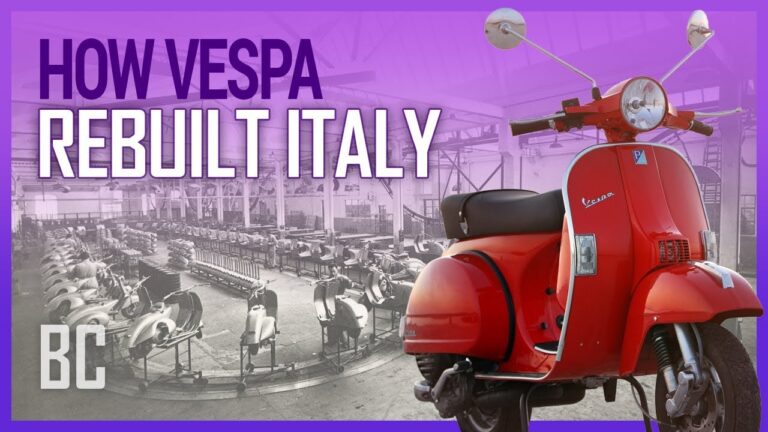Learn about Vespa, The Scooter that Rebuilt Italy based on Public Facts and Videos & Stories
Vespa Story based on Public Facts
Vespa is an Italian brand of scooter manufactured by Piaggio. The name means wasp in Italian. The Vespa has evolved from a single model motor scooter manufactured in 1946 by Piaggio & Co. S.p.A. of Pontedera, Italy to a full line of scooters and one of seven companies today owned by Piaggio. From their inception, Vespa scooters have been known for their painted, pressed steel unibody which combines, in a unified structural unit, a complete cowling for the engine (enclosing the engine mechanism and concealing dirt or grease), a flat floorboard (providing foot protection), and a prominent front fairing (providing wind protection).
Idea and Inception of Vespa
After World War II, in light of its agreement to cease war activities with the Allies, Italy had its aircraft industry severely restricted in both capability and capacity. Piaggio emerged from the conflict with its Pontedera bomber plane plant demolished by bombing. Italy’s crippled economy, and the disastrous state of its roads, were not immediately conducive to the re-development of the automobile market. Enrico Piaggio, the son of Piaggio’s founder Rinaldo Piaggio, decided to leave the aeronautical field in order to address Italy’s urgent need for a modern and affordable mode of transportation for the masses and this was the ultimate Idea for Inception of Vespa
The Story of Vespa Video
Learn in the above Video, The Impact WWII on Italian Economy and the Role of PIAGGIO in Revolutionising the Italian Automotive Industry? How was Vespa Named? And the Role of Movie Roman Holiday in making Vespa Popular Across the World and selling more than 100,000 units worldwide.
Patent Approval and Launch of Vespa
Piaggio filed a patent for the Vespa scooter design in April 1946. The application documents referred to a “model of a practical nature” for a “motorcycle with rationally placed parts and elements with a frame combining with mudguards and engine-cowling covering all working parts”, of which “the whole constitutes a rational, comfortable motorcycle offering protection from mud and dust without jeopardising requirements of appearance and elegance”.
The patent was approved the following December. The first 13 examples appeared in spring 1946, and revealed their aeronautical background. In the first examples, one can recognise the typical aircraft technology. Attention to aerodynamics is evident in all the design, in particular on the tail. It was also one of the first vehicles to use monocoque construction (where the body is an integral part of the chassis).
The company was aiming to manufacture the new Vespa in large numbers, and their longstanding industrial experience led to an efficient Ford-style volume production line. The scooter was presented to the press at Rome Golf Club, where journalists were apparently mystified by the strange, pastel coloured, toy-like object on display.
However, the road tests were encouraging, and even with no rear suspension the machine was more manoeuvrable and comfortable to ride than a traditional motorcycle. Following its public debut at the 1946 Milan Fair, the first fifty sold slowly. With the introduction of payment by instalments, sales took off.
Learn How Vespa Scooters are Made
Evolution and Worldwide Popularity of Vespa
Based on Public Facts
Piaggio sold some 2,500 Vespas in 1947, over 10,000 in 1948, 20,000 in 1949, and over 60,000 in 1950. Vespa clubs popped up throughout Europe, and by 1952, worldwide Vespa Club membership had surpassed 50,000. By the mid-1950s, Vespas were being manufactured under licence in Germany, the United Kingdom, France, Belgium and Spain; in the 1960s, production was started in India, Brazil and Indonesia.
Hollywood Impact on Vespa’s Global Sales
The biggest sales promo ever was Hollywood. In 1952, Audrey Hepburn side-saddled Gregory Peck’s Vespa in the feature film Roman Holiday for a ride through Rome, resulting in over 100,000 sales. In 1956, John Wayne dismounted his horse in favour of the two-wheeler to originally get between takes on sets as well as Marlon Brando, Dean Martin, and the entertainer Abbe Lane had become Vespa owners. William Wyler filmed Ben Hur in Rome in 1959, allowing Charlton Heston to abandon horse and chariot between takes to take a spin on the Vespa.
Vespa Becomes a Symbol of Freedom and Imagination
By 1956, one million had been sold, then two million by 1960.By the 1960s, the Vespa—originally conceived as a utility vehicle—had come to symbolise freedom and imagination, and resulted in further sales boosts: four million by 1970, and ten million by the late 1980s. Improvements were made to the original design and new models were introduced.


